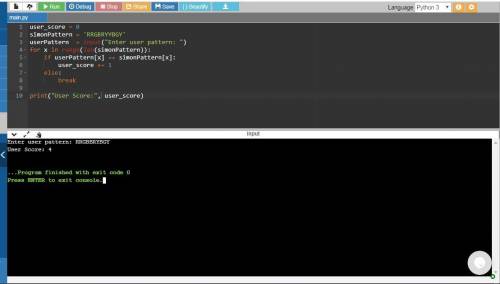
Computers and Technology, 28.07.2020 18:01 carmenmarie368
"Simon Says" is a memory game where "Simon" outputs a sequence of 10 characters (R, G, B, Y) and the user must repeat the sequence. Create a for loop that compares the two strings. For each match, add one point to user_score. Upon a mismatch, end the game. Ex: The following patterns yield a user_score of 4: simonPattern: R, R, G, B, R, Y, Y, B, G, Y userPattern: R, R, G, B, B, R, Y, B, G, Y

Answers: 1


Other questions on the subject: Computers and Technology

Computers and Technology, 21.06.2019 17:20, ooooooo828282828
When developing a stakeholder matrix, the portfolio manager must look at the portfolio governance in order to complete the stakeholder analysis. in your own words, what is the role, interest and expectations of the governance?
Answers: 3

Computers and Technology, 22.06.2019 05:10, ahoney2233
Suppose we have a byte addressable computer that has a 32-byte cache with 8 bytes per block. the memory address is 8 bits long. the system accesses memory addresses (in hex) in this exact order: 6e, b9, 17, e0, 4e, 4f, 50, 91, a8, ab, ad, 93, and 94. (a) assuming the cache is direct mapped, what memory addresses will be in cache block 2 after the last address has been accessed? (b) assuming the cache is direct mapped, what is the hit ratio for the entire memory reference sequence given, assuming the cache is initially empty? (c) assuming the cache is 2-way set associative with a lru replacement policy, what is the hit ratio?
Answers: 3

Computers and Technology, 23.06.2019 17:30, Annlee23
When making changes to optimize part of a processor, it is often the case that speeding up one type of instruction comes at the cost of slowing down something else. for example, if we put in a complicated fast floating-point unit, that takes space, and something might have to be moved farther away from the middle to accommodate it, adding an extra cycle in delay to reach that unit. the basic amdahl's law equation does not take into account this trade-off. a. if the new fast floating-point unit speeds up floating-point operations by, on average, 2ă—, and floating-point operations take 20% of the original program's execution time, what is the overall speedup (ignoring the penalty to any other instructions)? b. now assume that speeding up the floating-point unit slowed down data cache accesses, resulting in a 1.5ă— slowdown (or 2/3 speedup). data cache accesses consume 10% of the execution time. what is the overall speedup now? c. after implementing the new floating-point operations, what percentage of execution time is spent on floating-point operations? what percentage is spent on data cache accesses?
Answers: 2
You know the right answer?
"Simon Says" is a memory game where "Simon" outputs a sequence of 10 characters (R, G, B, Y) and the...
Questions in other subjects:

Mathematics, 23.07.2019 12:30



Mathematics, 23.07.2019 12:30


Spanish, 23.07.2019 12:30



Chemistry, 23.07.2019 12:30

History, 23.07.2019 12:30




